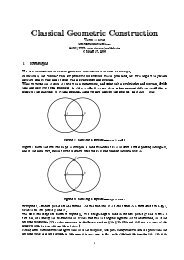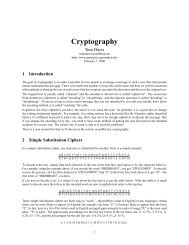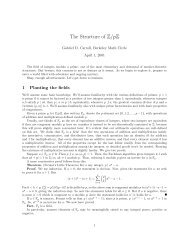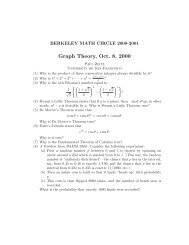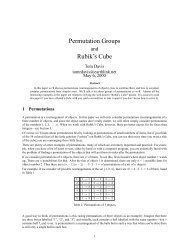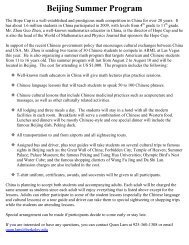Geometric Transformations with an Introduction to Techniques from ...
Geometric Transformations with an Introduction to Techniques from ...
Geometric Transformations with an Introduction to Techniques from ...
Create successful ePaper yourself
Turn your PDF publications into a flip-book with our unique Google optimized e-Paper software.
Questions<br />
<strong>Geometric</strong> <strong>Tr<strong>an</strong>sformations</strong> <strong>with</strong> <strong>an</strong> <strong>Introduction</strong> <strong>to</strong> <strong>Techniques</strong> <strong>from</strong><br />
Projective Geometry<br />
Part II<br />
Given a quadrilateral <strong>with</strong> <strong>an</strong> inscribed circle, as shown,<br />
prove that the diagonals <strong>an</strong>d the chords connecting the opposite<br />
points of t<strong>an</strong>gency are concurrent.<br />
Ted Cour<strong>an</strong>t<br />
Berkeley Math Circle<br />
September 29, 2009<br />
A straight irrigation ditch leads away <strong>from</strong> a s<strong>to</strong>rage t<strong>an</strong>k in the middle of a level field; the t<strong>an</strong>k is <strong>to</strong>o big <strong>to</strong> see over or around.<br />
How c<strong>an</strong> you continue the straight path of the ditch on the other side of the t<strong>an</strong>k using only marker pegs driven in<strong>to</strong> the ground?<br />
Exercises (continued)<br />
1. Given two circles, prove that the locus of points <strong>with</strong> equal Powers <strong>to</strong> the two circles is a line.<br />
AB<br />
2<br />
2. Prove that A' B' = r where O is the center of inversion, <strong>an</strong>d r is the radius of circle O.<br />
OA OB<br />
3. Prove that orthogonal circles remain fixed under inversion by each other.<br />
4. If two circles are orthogonal, then the diameter of one circle cuts the other in a pair of points which are inverses of one<br />
<strong>an</strong>other. Moreover, this is true of <strong>an</strong>y radial line of one circle which cuts the other circle in two points.<br />
5. Given three concurrent circles, how m<strong>an</strong>y circles may be constructed t<strong>an</strong>gent <strong>to</strong> all three?<br />
6. Prove that <strong>an</strong>y three disjoint circles c<strong>an</strong> be inverted in<strong>to</strong> circles whose centers are collinear.<br />
7. Use the picture below <strong>to</strong> provide <strong>an</strong> easy proof of Pascal's theorem: If a hexagon is inscribed in a circle, then the intersections<br />
of the three pairs of opposite sides are concurrent.
Projective Geometry<br />
1. Desargue's Theorem Prove that if two tri<strong>an</strong>gles are in perspective <strong>from</strong> a point, the three intersections of their corresponding<br />
sides are concurrent. Prove the theorem in space first, then attempt the pl<strong>an</strong>e version.<br />
2. Pappus' Theorem If the vertices of a hexagon lie alternately on two lines, then the three intersections of the pairs of<br />
opposite sides are concurrent.<br />
3. Bri<strong>an</strong>chon's Theorem If the sides of a hexagon pass alternately through two fixed points P <strong>an</strong>d Q, then the three<br />
diagonals joining opposite sides of the hexagon are concurrent.<br />
Suggested Reading<br />
Excursions in Geometry, C. St<strong>an</strong>ley Ogilvy (Dover Books)<br />
<strong>Introduction</strong> <strong>to</strong> Geometry, Coxeter (Wiley <strong>an</strong>d Sons)<br />
Geometry: A Comprehensive Course, D<strong>an</strong> Pedoe (Dover Books)<br />
Reflections on the Arbelos, Harold P. Boas, Americ<strong>an</strong> Mathematical Monthly 113 (March 2003)<br />
(http://www.math.tamu.edu/harold.boas/preprints/arbelos.pdf)<br />
Modern Geometries, James Smart (Brooks/Cole)<br />
tcour<strong>an</strong>t@bentleyschool.net



